Companies are using content marketing more. It costs 62% less than old methods and brings in three times more leads.
This strong strategy builds real connections and keeps people coming back. It is important now as we move into a time when customers care most about honesty.
How brands change will decide their paths.
Also read: how to set freelance writing rates and get paid what youre worth
The Heart of Content Marketing
Content marketing is about giving useful, clear information to draw in and hold the interest of the right people.
Unlike old marketing, which pushes its message, content marketing pulls people in with stories, lessons, and fun.
It is a careful plan that builds bonds, earns trust, and makes a brand respected over time.
This method delivers steady, good content that matches the needs and habits of the audience.
Businesses use blogs, videos, podcasts, and social media to spread their message, hoping to be seen as helpful rather than just sellers.
The growth of online communication and social media has sped up this change, as customers favor brands that connect with them in real ways.
In a time of doubt, content marketing makes brands look like trusted sources of knowledge, seeking loyalty and lasting relationships over quick profits.
What is Content Marketing
Content marketing means making and sharing helpful, steady content to attract and keep a clear audience.
The Content Marketing Institute says, “content marketing is a smart marketing and business plan focused on making and sharing valuable, clear, and steady content to attract and keep a clear audience.” The main aim is to get customers to take action that brings profit.
Here are some key parts of content marketing:
- Helpful Content: Aims to give useful information that solves audience problems.
- Targeted Messaging: Content is made for specific groups in the audience to improve connection and interest.
- Steady Engagement: Content is shared often for ongoing talks with the audience.
- Variety of Formats: This style uses many types—blogs, videos, pictures, and social media posts—to reach more people.
Main Traits of Content Marketing
- Audience-Focused: At the heart of content marketing is knowing and meeting the wants, needs, and worries of the target audience.
- Educational Method: Instead of just selling products or services, content marketing teaches the audience, giving them helpful ideas and facts.
- Engagement Focused: Content marketing highlights interaction, welcoming feedback and conversation.
- Long-Term Vision: It looks to build loyalty and relationships over time, not just quick sales.
Goals and Purpose of Content Marketing
Content marketing serves many purposes, mainly centered on building connections and gaining respect in the market.
The main goals include:
- Brand Recognition: Content marketing helps businesses grow their presence and stay in the minds of consumers.
- Lead Gathering: By sharing useful content, brands can pull in potential customers who need help with their problems.
- Customer Learning: Helping customers grasp products and services leads to better buying choices.
- Trust and Loyalty: Giving ongoing, helpful content builds trust and loyalty, creating long-lasting bonds with customers.
HubSpot says companies that focus on content marketing have six times better conversion rates than those that do not.
Also read: secrets to writing viral blog posts that rank on google
The Nature of Traditional Marketing
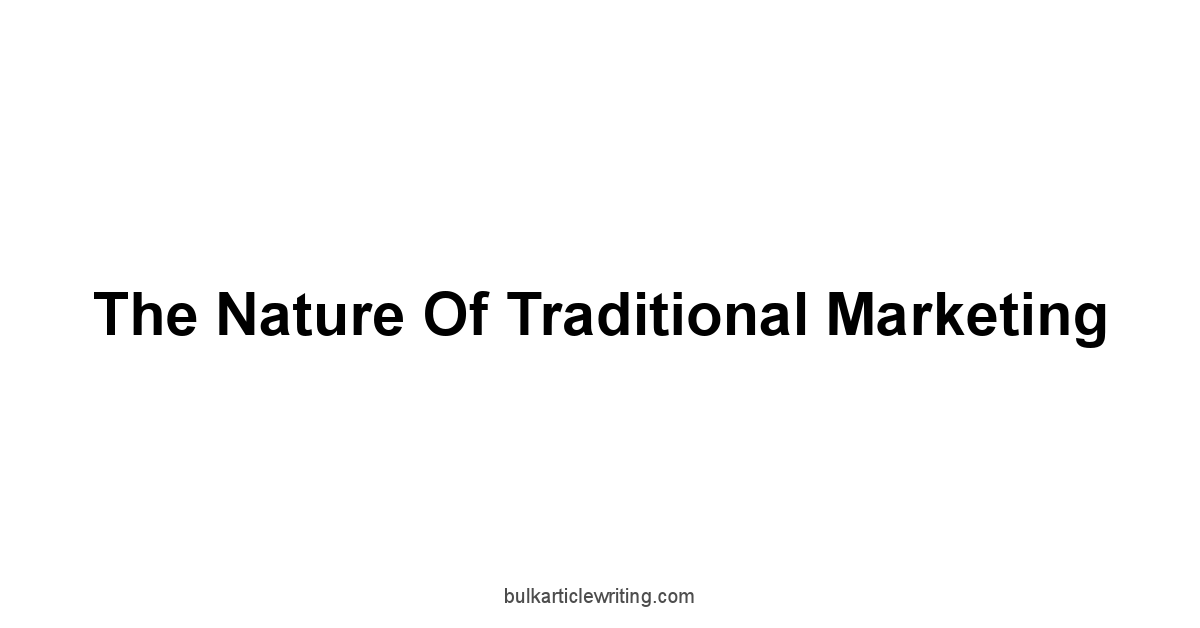
Traditional marketing is the base of many marketing strategies.
It uses clear methods to reach people through one-way communication.
This way usually includes television, radio, print ads, and direct mail, relying on interruption, not engagement.
The aim is to inform people about a product or service to prompt quick action, often seen in fast sales numbers.
Even with the growth of digital platforms, traditional marketing still holds power.
Many businesses still spend a large part of their budgets on traditional marketing, hoping to reach wide audiences through known channels.
The key is to see how traditional ways can work with modern strategies to improve overall effectiveness and reach.
Defining Traditional Marketing
Traditional marketing means the usual ways of promoting products or services through classic media.
These include physical ads like TV commercials, newspapers, radio ads, billboards, direct mail, and trade shows.
The main goal is to get immediate sales and increase brand awareness among many people.
The traits of traditional marketing can be summed up as follows:
- Mass Reach: Campaigns try to reach a large audience, making it possible to create many brand impressions.
- High Stakes: The costs of traditional ads – whether through buying time or making the ads – can be high.
- Short Duration: Ads usually play for short times, often leading to quick bursts of awareness.
Key Characteristics of Traditional Marketing
Several key traits make traditional marketing different from modern types:
- Interruption-Based: Traditional marketing often interrupts consumers with messages, needing them to stop to take in the ad. This is clear in TV commercials or radio spots that break into shows.
- Limited Engagement: The one-way nature of traditional marketing does not allow for back-and-forth conversation, making it hard for brands to connect with consumers.
- Quantifiably Challenging: Measuring the true effect of traditional marketing campaigns can be hard, often relying on estimates or broad impressions instead of clear facts.
- Targeting Limitations: Segmentation is less exact; while demographic data can help campaigns, targeting can miss smaller audiences effectively.
Purpose and Goals of Traditional Marketing
The main goals of traditional marketing include:
- Brand Awareness: To create visibility with target markets and encourage recognition.
- Immediate Sales: Prompting quick purchases through special offers or strong ad placements.
- Market Penetration: To enter new markets by reaching out to new audiences.
- Building Reputation: Creating a brand presence and building trust over time through steady messaging.
Despite its limits, traditional marketing can provide strong brand exposure.
Yet, it must adapt to modern consumers’ needs for engagement and relationship-building to stay effective.
Also read: a complete guide to google adsense approval for niche sites
Engagement Strategies in Marketing
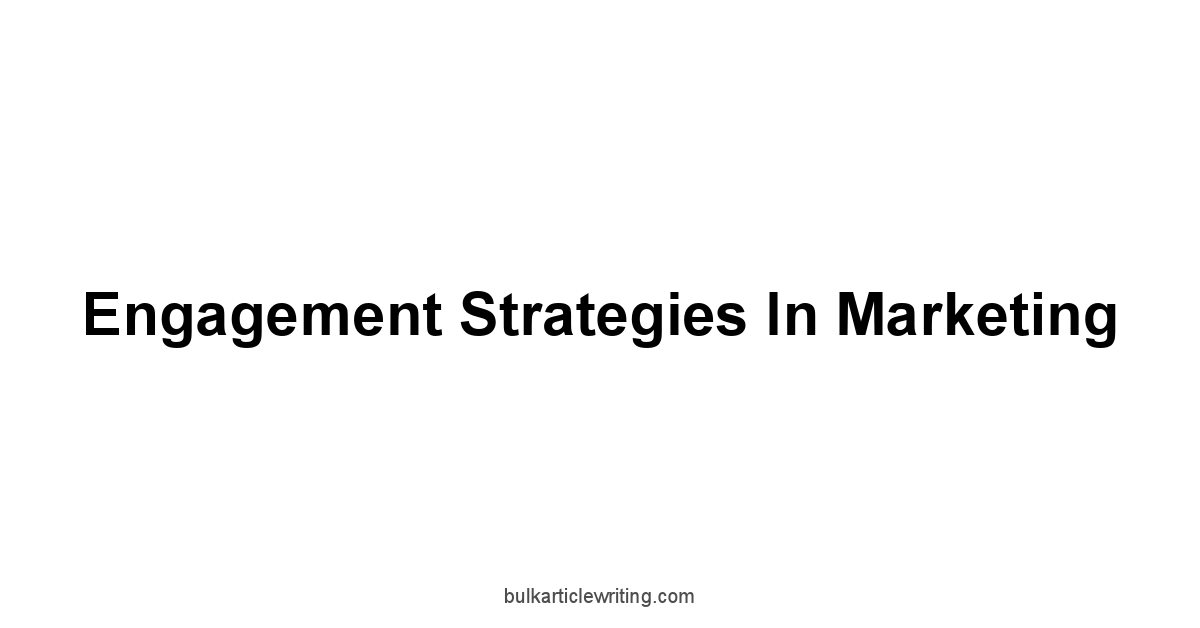
Engagement in marketing is how businesses talk to their audiences.
The need for real connections has made engagement vital in both content and traditional marketing.
Making strong engagement strategies is key to nurturing relationships, whether through personalized content marketing or broad traditional methods.
In content marketing, the aim is to build lasting relationships with valuable interactions.
Engagement is not just a quick link; it creates a path for ongoing talks, making bonds with the audience stronger.
Traditional methods, on the other hand, usually depend on one-way talks, leading to less engagement and fewer chances to interact.
Building Relationships through Content
Building bonds through content marketing means sharing a steady flow of useful information that meets audience needs.
This way creates a sense of community and mutual trust, which leads to deeper customer loyalty.
Real-time engagement, shown by social media, allows easy two-way talks, helping businesses respond to concerns, feedback, and needs quickly.
Benefits of building relationships through content:
- Increased Loyalty: Engaged customers are more likely to return for future visits and buys.
- Customer Retention: Good content strengthens ties, lowering loss rates in businesses.
- Advocacy: Well-informed customers may share their good experiences, helping word-of-mouth marketing.
One-Way Communication in Traditional Methods
Traditional marketing is mainly one-way, where info goes from the brand to the consumer without asking for replies.
Though traditional ads can create a brand presence, they don’t often encourage ongoing talks.
One-way communication limits timely feedback, leaving brands with little understanding of customer feelings.
Some downsides of one-way communication in traditional marketing include:
- Lack of Feedback Loops: Brands often miss important feedback that could strengthen ties or improve products.
- Decreased Consumer Engagement: Consumers may be less willing to connect or talk with a brand when there’s no interaction.
- Missed Opportunities for Personalization: Traditional strategies often miss tailored marketing, ignoring chances to fit messages to individual audiences.
Long-Term vs Short-Term Engagement
The main difference between content marketing and traditional marketing lies in how long they engage.
Content marketing aims for long-term engagement, focusing on building relationships through ongoing value.
In contrast, traditional marketing often seeks quick results, working for immediate sales without caring for future engagement.
Key points that set apart long-term and short-term engagement:
- Value Proposition: Long-term engagement is about offering value all the time, while short-term strategies need quick hooks or deals.
- Investment in Relationships: Content marketing needs time spent on creating strong customer bonds, which will pay off as trust builds.
- Measurement of Success: Long-term engagements look at customer lifetime value and retention rates, unlike short-term measures like immediate sales or visibility.
Also read: top 5 reasons why google adsense applications get rejected
Cost Analysis of Marketing Approaches

The money involved in marketing choices matters in planning.
When looking at content marketing and traditional marketing, it is vital to compare the costs of each to find which one brings a better return.
Cost analysis shows the details of marketing spending and must think about both initial costs and ongoing costs, as well as the returns expected from each method.
Evaluating Content Marketing Costs
Content marketing is often seen as cheaper than traditional marketing.
The money needed to make and share digital content is usually less than what is spent on traditional media.
Creating content has costs, but these are often less than the potential for better engagement and lasting value.
Some costs tied to content marketing include:
- Content Creation: Writing, making videos, graphic design, and other efforts to develop content.
- Distribution: Money spent on promoting content, like paid ads on social media or sponsored posts.
- Tools and Platforms: Investing in systems to manage content, SEO tools, and resources to check success.
A study by Demand Metric found that content marketing costs about 62% less than traditional marketing while bringing in about three times as many leads.
Evaluating Traditional Marketing Costs
On the other hand, traditional marketing often has big costs that can hurt budgets.
Key expenses include:
- Production Costs: High costs linked to video ads, print materials, and other promotional tasks. For example, making a 30-second TV ad can cost between $20,000 and $1 million.
- Media Buying: Paying for airtime, print space, or billboards can lead to huge costs, especially in busy markets.
- Campaign Management: Ongoing costs for managing campaigns, checking their success, and changing strategies might go beyond initial plans.
Traditional marketing’s cost-effectiveness is doubtful when thinking about the ability to measure real results against the reach.
Cost-Effectiveness of Content Marketing
Content marketing is clearly cost-effective compared to traditional marketing.
Though there are initial costs for creating content, brands can benefit from content that continues to bring engagement long after it is released.
This lasting reach leads to lower costs per conversion and often a better ROI.
- Sustainability: Content stays available for long periods, allowing for more traffic and ongoing engagement without extra costs.
- Repurposing: Old content can be used again across different channels and formats, saving on creation costs and expanding reach.
- Measurable Impact: With advanced tools, brands can easily see how well content performs and change strategies in real-time.
Knowing these financial details helps marketers allocate funds wisely and get the most value from their marketing efforts.
Also read: how to leverage social media for digital marketing success
Return on Investment ROI
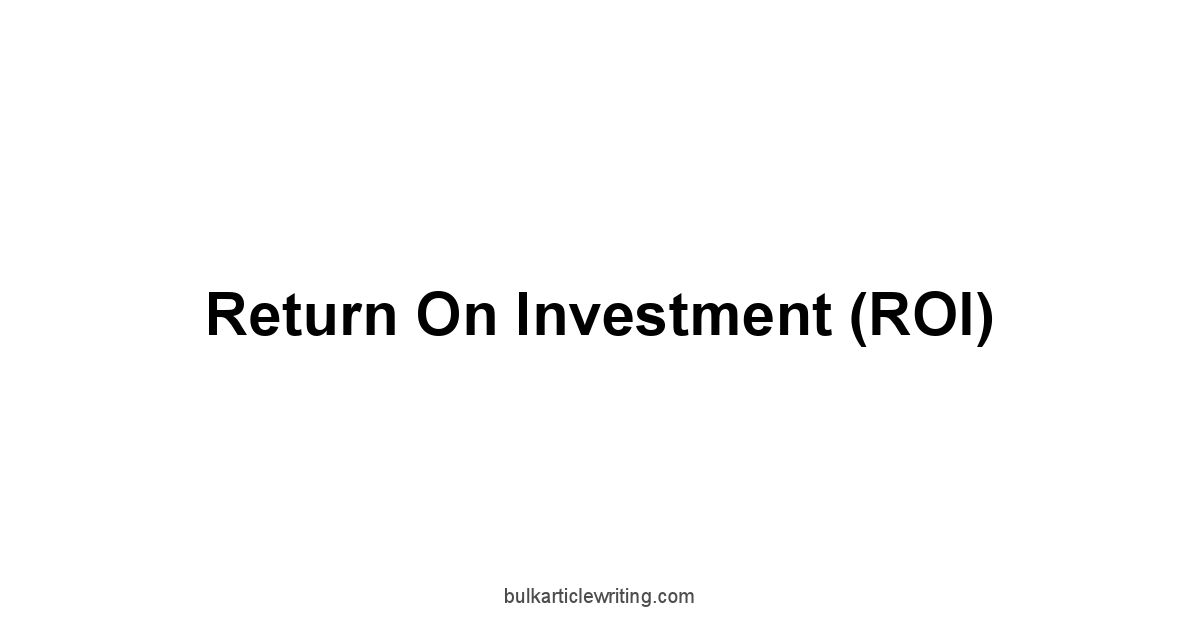
Return on Investment ROI is a key way to measure how well marketing works.
It shows how marketing plans turn into money, helping to judge if content marketing does better or worse than traditional marketing.
Looking at ROI not only shows how money is made but also how well customers are engaged, how loyal they are, and how the business grows.
Understanding ROI in Content Marketing
Content marketing usually gives a better return on investment than traditional marketing.
Because it aims to engage and provide value, good content strategies can greatly boost what customers are worth over time.
Key reasons for content marketing’s strong ROI:
- Longer Engagement Cycle: Good content builds lasting bonds, which leads to repeat buys and recommendations.
- Better Conversion Rates: A report by HubSpot shows that companies using content marketing well can have conversion rates 6 times higher than those that don’t.
- Referrals and Shares: Good content is shared more, increasing reach without more marketing cost.
Measuring ROI in content marketing means figuring out the money made from content-driven sales while also looking at the costs of making and sharing that content.
ROI Challenges in Traditional Marketing
Finding ROI in traditional marketing has clear challenges.
Problems arise from the difficulty in tracking results, leaving brands to guess or use less accurate measures.
Some main challenges include:
- Lack of Real-Time Data: Unlike online marketing, where data comes quickly, traditional marketing effects often take time to show.
- Attributable Conversions: It gets harder to see which part of the marketing worked when campaigns run across many paths.
- High Costs with Limited Data: The big upfront money needed for traditional marketing means more careful checks, especially when seeing how these costs turn into sales.
Metrics for Measuring Marketing ROI
Important to understanding ROI are the measurements companies need to keep track of.
To get better returns, marketing efforts should be looked at using different numbers and facts, such as:
- Conversion Rate: Finding the percentage of actions that lead to what is wanted. This shows how well marketing makes people act.
- Customer Acquisition Cost: Figuring out the total cost of getting new customers compared to the money these customers bring in.
- Lifetime Value: Looking at long-term profit from each customer to see how good both keeping and getting customers are.
- Engagement Metrics: Examining how content performs through numbers like views, shares, comments, and overall interaction gives a clearer view of user activity.
In both methods, regularly measuring and reviewing these numbers allows companies to change their tactics based on what works, leading to better returns on investment.
Also read: how to choose the perfect niche for your blog
Audience Targeting and Reach

Finding the right audience is key to any good marketing plan.
Getting businesses to engage with the right people is vital for good results.
When we look at content marketing and old-school marketing, we must see how each one finds and reaches its audience.
Content marketing usually uses careful, detailed targeting based on deep audience study, while traditional marketing casts a wider net over larger groups.
Defining Target Audiences in Content Marketing
In content marketing, knowing the audience means careful study and sorting.
Understanding what the audience does, needs, and likes helps businesses make content just for them.
This careful targeting leads to better engagement and a stronger brand bond.
Important parts to define target audiences are:
- Demographics: Age, gender, income, and education to make sure content fits different audience groups.
- Psychographics: Interests, values, and lifestyles help connect with audiences on a deeper level.
- Behavioral Data: Watching how customers interact with content helps guess what they might do next, leading to better messaging.
With tools like Google Analytics, marketers can check interest levels among groups, refining target segments for better reach.
Audience Targeting in Traditional Marketing
Traditional marketing uses broader targeting methods, mostly because of how its ads work.
Some common ways to target audiences in traditional marketing are:
- Geographic Segmentation: Placing ads based on location to reach people in certain areas.
- Demographic Characteristics: Ads aimed at specific ages, genders, or jobs based on set ideas.
- Timing and Placement: Using planned slots for radio or TV shows aimed at certain people, trying for peak engagement.
Though traditional marketing can get many views, its broad methods often miss smaller audiences.
Strategies for Maximizing Reach in Both Approaches
Getting the most reach from both content and traditional marketing takes a mix of strategies to boost visibility and engagement.
- Cross-Promotion: Using different platforms social media, email, websites, print spreads messages across both ways.
- High-Quality Content: Whether traditional ads or online content, giving solid, relevant material can help messages stick.
- Audience Engagement: Get people to interact through social media, website comments, or feedback from traditional ads.
- Analytical Insights: Use data to refine and change targeting methods constantly, ensuring efficiency in reaching key groups.
By knowing how to define and engage target audiences, businesses can strengthen their marketing plans and gain better results, mixing the strengths of both content and traditional marketing.
Also read: how to increase adsense revenue with seo strategies
Content Creation and Distribution
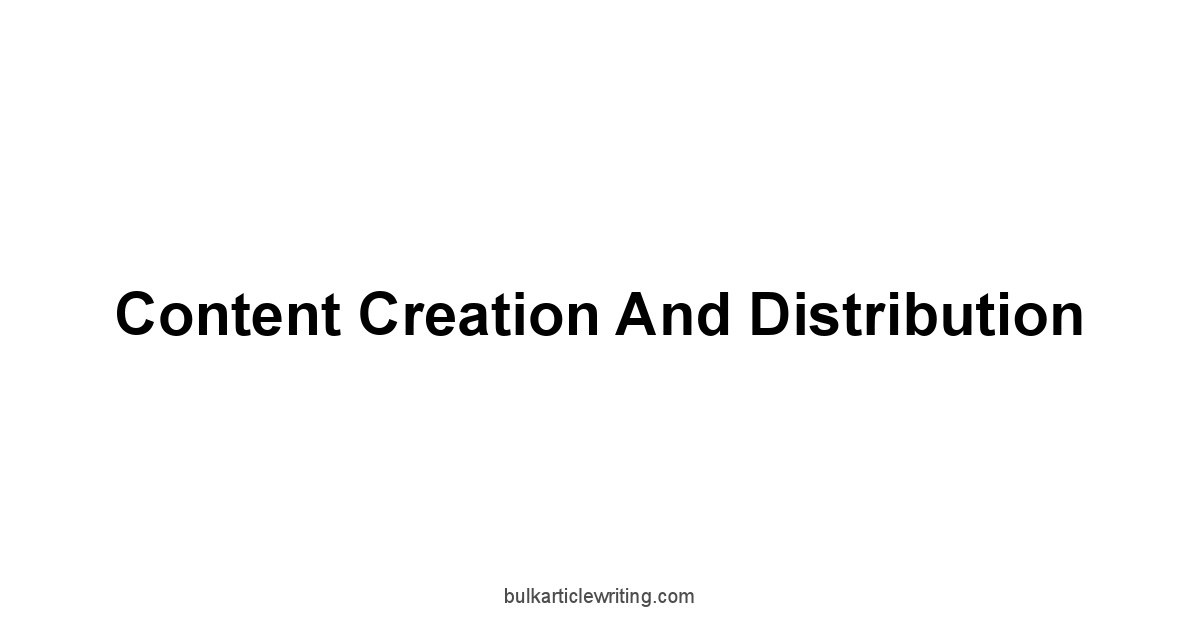
Content creation and distribution are key parts of any marketing plan.
How content is made and shared can change how far it reaches, how people engage, and how well it works.
In content marketing compared to traditional marketing, the ways content is made and shared are very different. It is vital to create good content for the right audience.
Elements of Effective Content Creation
Good content creation depends on several main parts that work together to keep the audience interested.
Setting clear goals, knowing the audience, and having strong messages are the base of a good content strategy.
Key parts include:
- Relevance: Content must meet the audience’s needs and interests to connect and encourage engagement.
- Quality: Making good, engaging material is key. Badly made content can harm a brand’s standing and turn away potential customers.
- Research-Based: Knowing the industry, audience, and competitors well helps create content that informs and builds trust.
- Diverse Formats: Using different formats—blogs, videos, infographics, podcasts—meets the tastes and habits of different audiences.
In making good content, brands must aim for uniqueness while staying true to their voice, allowing for special storytelling that grabs attention.
Distribution Channels for Content Marketing
Distribution channels are crucial to ensure content reaches the right audiences.
Content marketing uses many digital channels to increase visibility, letting brands change their distribution tactics based on what the audience likes.
Some common distribution channels are:
- Social Media Platforms: Using sites like Facebook, Instagram, LinkedIn, and Twitter to share content and connect with people directly.
- Email Newsletters: Sending helpful content through email campaigns, keeping audiences informed and engaged.
- Websites and Blogs: Sharing content on branded websites or blogs keeps everything in one place.
- Paid Advertising: Using paid media strategies, like PPC and sponsored content, to boost visibility in crowded markets.
Choosing the right distribution channels based on how the audience behaves is key to reaching and engaging more people.
Distribution Strategies in Traditional Marketing
Traditional marketing relies on broad channels that may make distribution slower and less flexible than digital methods.
Still, companies often mix traditional methods successfully.
Common distribution strategies in traditional marketing include:
- Print Advertising: Using newspapers, magazines, or brochures to sell products or services. This works well for local campaigns and can prompt quick responses.
- Broadcast Media: Advertising on radio and television, using peak times to reach large audiences at once.
- Event Sponsorships: Connecting with consumers directly through events or trade shows, creating engagement that is more than just buying.
- Direct Mail Campaigns: Sending physical marketing materials to specific homes, which can have high engagement rates when tailored well.
While traditional distribution needs a lot of upfront money, good placements can create broader audience reach and brand awareness.
Also read: how to combine blogging and affiliate marketing for maximum profit
Measuring Success

Measuring success in marketing is key to knowing what works and guiding the next steps.
Strong metrics and analytics help businesses look at content marketing and traditional marketing results. This leads to smart choices that improve overall success.
Each method needs different ways to measure, fitting their goals, methods, and audiences.
Key Performance Indicators for Content Marketing
Good signs of successful content marketing show businesses the impact and areas to grow.
KPIs might be:
- Organic Traffic Growth: Tracking rises in site visitors from content shows audience interest clearly.
- Social Shares and Engagement: Looking at actions on social media shows how content connects while showing brand reach and loyalty.
- Lead Conversion Rates: Checking how well content brings in leads and conversions helps figure out if the material is effective in guiding prospects to buy.
- Customer Retention Rates: Watching returning customers shows loyalty built through useful content and long-lasting ties.
By checking these KPIs, companies can see how well their content works and keep improving their plans.
Metrics for Evaluating Traditional Marketing Success
For traditional marketing, key metrics are:
- Reach and Impressions: Counting how many people see an ad and how often they see it.
- Cost Per Impression CPI: Looking at the cost for every one thousand views can show how well the budget works.
- Sales Growth Post-Campaign: Checking sales growth after ads helps show the impact of spending on marketing.
- Brand Recognition Surveys: Surveys that measure brand recall before and after campaigns show the success of traditional marketing.
While traditional marketing uses broader data, these metrics are still important for meeting clear goals.
Tools for Tracking Marketing Effectiveness
Tracking marketing success in content and traditional marketing needs special tools made for measuring and analysis.
In content marketing, popular tools are:
- Google Analytics: Tracks website traffic, user behavior, conversions, and overall patterns.
- Social Media Analytics: Gives insights into engagement, audience makeup, and post success on social media.
- Content Marketing Software: Tools like HubSpot and SEMrush help businesses check content success across many channels.
For traditional marketing, good tracking methods include:
- Surveys and Questionnaires: Getting customer feedback on ad exposure can show how well campaigns work.
- Media Monitoring Tools: Services like Cision help keep track of traditional media mentions.
- Sales Data Analytics: Linking advertising costs straight to sales numbers helps see the effectiveness.
Using a mix of these tools leads to insights that help improve marketing plans as time goes on.
Also read: how to combine blogging and affiliate marketing for maximum profit
Adapting to Market Trends

Adapting to market trends brings both chances and problems.
In a fast-changing world, marketing plans must be flexible. They need to respond to what customers want and to new technology.
Knowing how to change direction is key. It helps brands stay ahead and stay important.
Content marketing shines in this changing world. It is naturally easy to adjust.
On the other hand, traditional marketing can struggle. It often relies on strict planning that takes time.
Flexibility of Content Marketing
Content marketing has a lot of flexibility. It lets brands change their messages fast to match new trends and feedback from audiences.
This ability to adapt means better content strategies for different groups of consumers. It helps keep them engaged.
Key parts of content marketing flexibility are:
- Fast Content Creation: Brands can quickly make content that fits current trends. This keeps marketing timely and relevant.
- Multi-Channel Distribution: Content can be shared on many platforms. This allows quick changes to reach the right audiences.
- Real-Time Analytics: Looking at performance data helps marketers adjust quickly based on immediate feedback.
Challenges of Adapting Traditional Marketing
Traditional marketing finds it hard to change with trends. This is partly due to needing longer planning and more resources.
Some problems are:
- Stiff Budgets: Spending money on old campaigns can stop quick changes when the market shifts.
- Slow Response: Traditional ads often cannot move fast enough to new trends or changes in culture.
- Stopped Innovation: Sticking to what is known can limit creativity. This leads to old strategies that do not connect with people.
These problems show why businesses must keep looking at their traditional marketing alongside modern approaches.
Good marketers know the need to be quick and to change often. They adapt and keep thinking of new ideas to keep their brands strong.
Using insights from audience feedback and trends helps businesses meet customer needs and industry changes.
In dealing with these changes, brands can:
- Find New Chances: Being open to new strategies shows new channels and audiences.
- Stay Important: Adapting to what customers want keeps marketing fresh and useful.
- Boost Returns: Change leads to better results in both content and traditional marketing over time.
Also read: how to find high traffic blog topics for your niche
Establishing Authority and Trust
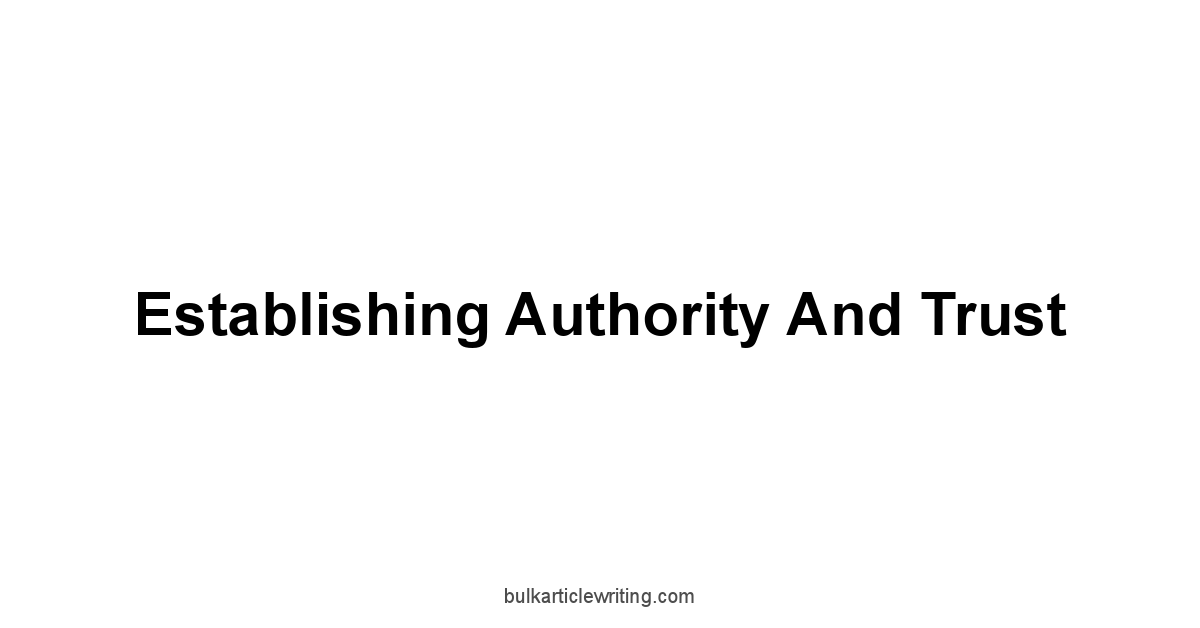
Successful marketing starts with authority and trust.
Brands seen as credible and knowledgeable gain more loyalty and engagement from customers.
Building these traits sets apart content marketing from traditional marketing, changing how consumers view and connect with brands.
Content marketing focuses on providing value. Traditional marketing often depends on brand reputation or famous names to seem credible.
Authority Building through Valuable Content
Content marketing builds authority by offering useful and relevant content to the right audiences.
By facing industry problems, sharing knowledge, and giving solutions, brands can engage their audiences and become leaders in their field.
Key strategies include:
- Expert Contributions: Using smart voices from the industry through guest posts, podcasts, or webinars boosts the brand’s credibility.
- Educational Resources: Making detailed guides, reports, and studies gives audiences valuable info and shows expertise.
- Responsive Interaction: Engaging consumers through comments or social media builds trust and creates a community around the brand.
Research shows 81% of consumers need to trust a brand to buy from it, making authority vital.
Trust Issues in Traditional Advertising
Traditional marketing has trust issues because it often interrupts.
Consumers are more doubtful of ads, leading them to question if traditional messages are real.
Trust issues come from:
- Overpromising Messaging: Brands that make big claims face distrust, hurting their credibility.
- Low Engagement Opportunities: The one-way style of traditional marketing limits chances for connection, creating distrust.
- Generic Campaigns: Ads targeting wide audiences often feel too general, leaving consumers feeling alone in the brand message.
In this space, gaining trust can be tough. Brands need to find new ways to bring transparency and connection.
Impact of Trust on Consumer Decisions
Trust shapes how consumers make choices.
When brands feel real and trustworthy, they build loyalty and get conversions.
Research shows that brands seen as trustworthy find success through lasting relationships.
Ways to build trust include:
- Building Transparency: Sharing brand values, actions, and results openly builds accountability in consumers’ eyes.
- Social Proof and Reviews: Using customer testimonials or case studies shows real-world satisfaction, boosting trust.
- Consistent Branding: Keeping a clear brand identity across all platforms aligns messages and increases trust and recognition.
By focusing on building trust and authority, brands can create meaningful relationships with their audience, leading to more engagement and loyalty over time.
Also read: how to choose the perfect niche for your blog
Future of Marketing
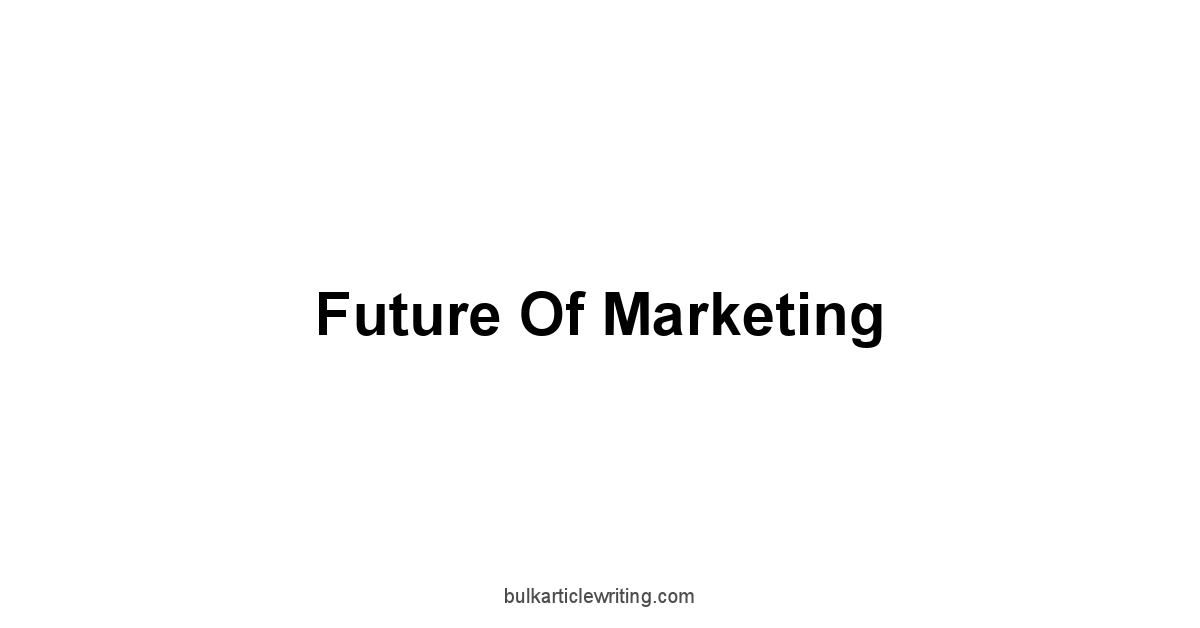
As markets change, so must plans. Brands need to be flexible and think ahead to stay relevant.
Knowing the trends that affect content and traditional marketing will help in guessing what will work in the years to come.
Trends Influencing Content Marketing
Several trends now shape content marketing, hinting at growth and change.
Businesses should be ready to use new practices to improve engagement and keep their audience.
- More Focus on Personalization: People want experiences made for them. This leads content makers to change plans based on what users like.
- Data-Driven Strategies: Using data and analysis will guide what content is made and shared, leading to better returns.
- Focus on Quality over Quantity: A move toward making high-quality content instead of just a lot will help brands connect better with their audiences.
- Growth of Visual and Interactive Content: More visual media, like videos and infographics, shows what audiences prefer, leading to better campaigns.
These trends will change how content is made, shared, and seen, improving the success of content marketing.
The Evolution of Traditional Marketing
Traditional marketing may seem old, but it still changes with how people act and what they want.
Brands must modify their methods to stay effective, mixing old methods with new technology.
Key changes include:
- Mix with Digital: Traditional marketing is being paired with digital methods, giving a wider reach and better data.
- Use of Data: Using data to target and measure helps traditional marketing show clear signs of success.
- Better Targeting: New tools for audience segments help traditional marketers reach specific groups more easily.
As these changes happen, traditional marketing will blend with digital trends, creating new strategies.
Predictions for Marketing Effectiveness
Looking ahead, a mix of content and traditional marketing will arise, changing how brands meet their audiences.
As consumers ask for honesty, accountability, and value, marketers must adjust.
Some predictions for future marketing success include:
- More focus on storytelling: Brands that tell good stories instead of just selling things will grab attention.
- Growth in Content Marketing: With better returns and results, content marketing will continue to be a key strategy for many industries.
- Interactivity in Advertising: Regular ads will move to more interactive styles that invite audience involvement, building engagement.
- More Personalization: As data helps understand audiences, brands will use personalization better in both content and traditional methods.
Also read: how to choose the perfect niche for your blog
Final Thoughts
Content marketing shows this change. It highlights the need for valuable content that connects with consumers.
As businesses face new consumer needs and tech changes, those telling real stories and engaging meaningfully will succeed.
Research shows that 70% of consumers like to learn about products through content. This means content marketing plays a key role in today’s consumer ties.
The big difference between content and traditional marketing is in how they work.
Traditional marketing often focuses on one-way talks that aim for quick results. Content marketing builds long-term ties through ongoing conversations.
Engagement keeps marketing alive. It builds trust and loyalty, turning regular customers into brand supporters.
Companies that put money into content marketing see six times more conversions than those stuck in traditional ways.
So, taking a content-first approach boosts trust and can increase profits over time.
Looking ahead, being flexible will be key.
More personal touches and decisions based on data will steer content plans, making sure messages are not just broad but direct and useful.
Educational tools, community ties, and a strong focus on consumer needs will mark successful marketing in the future.
Riding the wave of change, brands must stay alert and quick to adapt to new trends.
Building trust, establishing authority, and focusing on engagement will shape the leaders in the field.
By adopting a strong content marketing plan, businesses can build lasting bonds that go beyond simple sales, leading to real growth and success in a tough market.
Also read: how to use social media to promote your blog content
Frequently Asked Questions
Which is more effective, traditional or digital marketing?
Digital marketing is usually more effective.
It lets you target specific groups and saves money.
You can reach the right people and see how your campaign is doing right away, changing things as needed.
Traditional marketing is strong but can struggle to engage people in a world full of information.
In today’s world, being able to change and improve makes digital marketing a strong choice.
Is influencer marketing more effective than traditional marketing?
Influencer marketing is often more effective.
Influencers have built trust with their followers.
Their suggestions matter.
This personal link leads to more engagement and sales.
Traditional ads, on the other hand, can get lost in many messages, missing the personal touch that brings results now.
Which type of marketing is better?
It depends on your needs and what you have.
Digital marketing is great for saving money and reaching small groups.
Traditional marketing still works well, especially for reaching a larger audience.
Pick based on your specific business needs and who you want to reach.
A mix of both can often bring the best results, using the strengths of each.
What is the number one most effective form of marketing?
Word of mouth is still the most effective way to market.
It is real, natural, and often can’t be stopped.
When people share their good experiences, they help spread your message far away.
What is the most effective marketing method?
Content marketing is very effective.
It is about building connections and giving value with helpful and interesting materials.
This way builds loyalty and makes your brand respected in your field.
When done well, it forms a strong bond with your audience that traditional ads often don’t create.
Which marketing method has the highest success rate?
Email marketing usually has the highest success rate.
It lets you talk directly with your audience, building relationships with targeted messages.
Unlike traditional mail, email campaigns can be watched and changed for the best effect.
When used with segmentation strategies, email marketing can give big returns.
What is the most effective form of marketing research?
Surveys and customer feedback are the best ways to do marketing research.
They give you direct insights from your audience.
Knowing what they need and want helps you refine your strategies for better results.
What is the most powerful type of marketing?
The strength of marketing is in word of mouth.
This style relies on being real and building trust.
It doesn’t need a budget.
It’s just people sharing their experiences.
Using happy customers can turn them into supporters for your brand, increasing your reach in a real way that other methods can’t match.
What is the most effective content marketing?
Video marketing is one of the most effective forms of content marketing.
It grabs and informs your audience, showing a lively view of your brand.
Studies show that 93% of consumers say videos help them decide to buy.
Making good video content can greatly improve engagement and help your audience connect more deeply with what you offer.
What is the most effective direct marketing form?
Email marketing is the top form.
It lets businesses connect directly with their audience through custom messages.
This personal touch builds connections and leads to sales.
When done right with segmentation and personalization, email marketing becomes a powerful tool for reaching your business goals.
Also read: secrets to writing viral blog posts that rank on google

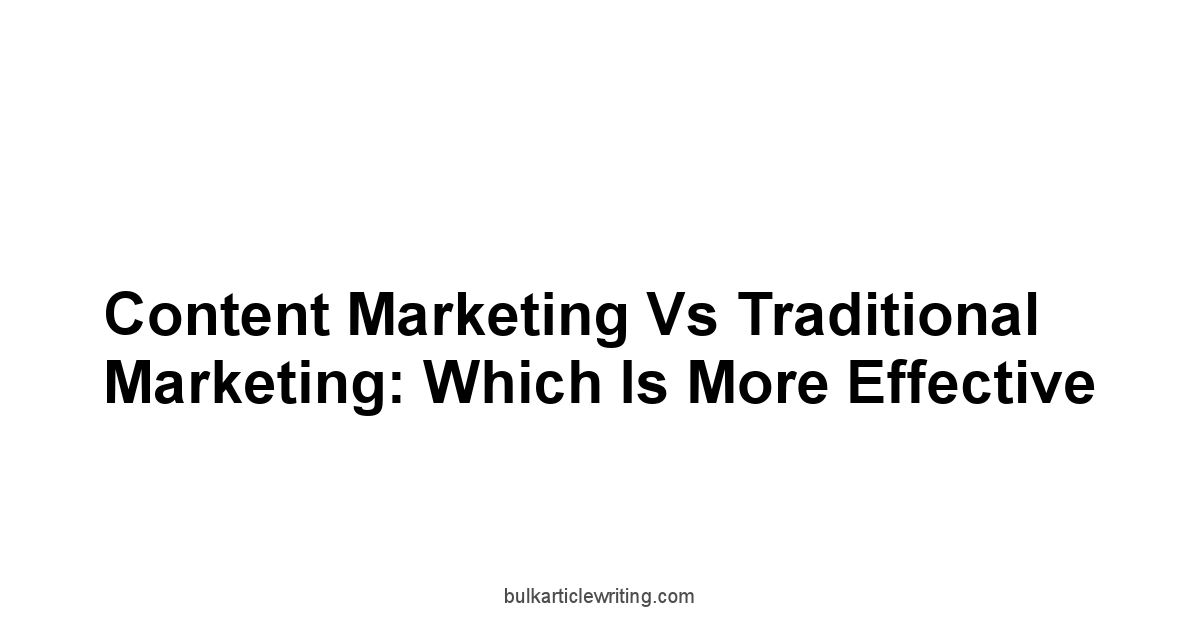
Leave a Reply